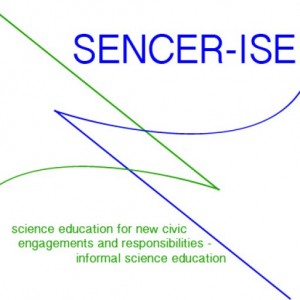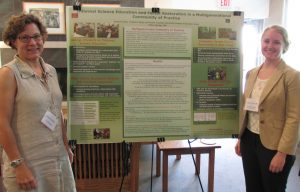 SENCER-ISE (Science Education for New Civic Engagements and Responsibilities – Informal Science Education) is currently a three-year project funded by the National Science Foundation (DRL-1237463) and the Noyce Foundation. The initiative represents the National Center for Science & Civic Engagement’s (NCSCE) efforts to encourage educators from formal higher education and informal science institutions to work together to develop meaningful science based learning experiences for students and the public. Through SENCER-ISE, NCSCE provides support for ten cross-sector partnerships between different types of museums and undergraduate institutions, which can involve science researchers but also involve the participation of undergraduate and graduate students in partnership activities.
SENCER-ISE (Science Education for New Civic Engagements and Responsibilities – Informal Science Education) is currently a three-year project funded by the National Science Foundation (DRL-1237463) and the Noyce Foundation. The initiative represents the National Center for Science & Civic Engagement’s (NCSCE) efforts to encourage educators from formal higher education and informal science institutions to work together to develop meaningful science based learning experiences for students and the public. Through SENCER-ISE, NCSCE provides support for ten cross-sector partnerships between different types of museums and undergraduate institutions, which can involve science researchers but also involve the participation of undergraduate and graduate students in partnership activities.
In this blog, we will provide a general overview of SENCER-ISE. In subsequent posts, we will highlight some of the partnerships that include learners of all ages in science practices and science communication efforts.
Building an Initiative
SENCER-ISE is an outgrowth of NCSCE’s signature program, SENCER. Funded by the National Science Foundation (DUE-1224488), SENCER focuses on the improvement of undergraduate STEM teaching and learning through the framework of civic engagement and the development of coursework that is both authentic and relevant to students.
In the late 2000s, the NCSCE leadership and others beyond this community recognized the relationship between the work of informal science educators and that of formal educators who were developing science courses using the SENCER model. The 2009 National Research Council publication Learning Science in Informal Environments reinforced the belief that there were commonalities in learning goals. Briefly, the six strands of learning for informal science education and SENCER theory and practice both emphasize starting with areas of interest to learners, having learners participate in science practices, and encouraging learners to think of themselves as individuals who are users of science.
Under the leadership of the late Alan J. Friedman and with funding from the National Science Foundation (DRL-1001795) and the Noyce Foundation, NCSCE organized an invitational conference in March of 2011 with over 40 participants who came from 19 states, the District of Columbia, Canada, Chile, and Israel, and who represented a range of informal science educators and science faculty who were involved with SENCER. While participants recognized differences between the sectors in approaching educational experiences, by the end of the meeting there was a general consensus that forming equitable partnerships focusing on a civic issue should be further explored. For more information, see the March 2011 Executive Summary andconference proceedings, and Dr. Alan J. Friedman and Dr. Ellen Mappen’s project report in Science Education & Civic Engagement: An International Journal.
SENCER-ISE Partnerships
 The goals of SENCER-ISE are to: 1) support partnerships between higher education and informal science education professionals around compelling civic issues and examine whether these partnerships can bring about a transformation in STEM educational practices, 2) help create durable partnerships between educators from these sectors and by so doing provide models for others in the wider educational community to follow, and 3) instill in college graduates and the general public the idea that informal science education institutions and activities are credible, accessible sources of high quality “life-long learning” on matters of science, public policy, personal well-being, and public welfare.
The goals of SENCER-ISE are to: 1) support partnerships between higher education and informal science education professionals around compelling civic issues and examine whether these partnerships can bring about a transformation in STEM educational practices, 2) help create durable partnerships between educators from these sectors and by so doing provide models for others in the wider educational community to follow, and 3) instill in college graduates and the general public the idea that informal science education institutions and activities are credible, accessible sources of high quality “life-long learning” on matters of science, public policy, personal well-being, and public welfare.
The ten cross-sector partnerships current part of SENCER-ISE include:
- Antioch College & the Glen Helen Outdoor Education Center
- Brooklyn College of CUNY & the Gateway National Recreation Area
- Hamilton, Hope, and Oberlin Colleges & Green Science Policy Institute
- New Mexico Experimental Program to Stimulate Competitive Research & the New Mexico Museum of Natural History and Science
- Paul Smith’s College & The Wild Center
- Cornell University & the Sciencenter
- Fordham University & the Wildlife Conservation Society
- Raritan Valley Community College & the New Jersey Audubon Society
- Saint Mary’s College of California & the Lindsay Wildlife Museum
- University of Connecticut & the Connecticut Science Center
The partnerships represent projects that involve students in science practices addressing issues of civic consequence, such as forest health and invasive species, toxicology of household products, cognitive development of young learners, coastal resilience, and urban ecology. For brief descriptions of the partnership projects, view our online brochure.

Linda Fuselier, left, and Janene Giuseffi, present their project to fellow 2014 SENCER Summer Institute participants.
In addition to the partnerships evaluating the effectiveness of their individual projects, an external evaluator, Randi Korn & Associations (RK&A), is continuing to assess the effectiveness of the SENCER-ISE project as a whole. RK&A conducted a formative evaluation, which examined the perceptions of the SENCER-ISE support infrastructure partnership efforts—including the project website, attendance at NCSCE meetings, evaluation training, etc. which provided a clearer understanding of what supports are needed to sustain partnerships. RK&A will also undertake a summative evaluation to explore changes in the partners’ understanding of each other’s field of expertise, and to examine what constitutes a durable partnership between the informal science and higher education sectors.
One of SENCER-ISE’s goals is to help create durable and sustainable cross-sector partnerships that will last beyond the length of the grant period. Several partnerships have successfully traversed the challenges associated with personnel turnover with the support of SENCER-ISE management and the commitment to a shared sub-award. Now halfway through their SENCER-ISE sub-award, a number of partnerships are making concerted efforts to institutionalize their partnership and to share the results of their efforts with educators in both sectors. We’ll dive more deeply into these examples in future posts on InformalScience.org.
A Final Note—Furthering the Discussion
The impetus to write this blog about SENCER-ISE was sparked by the December 2014 CAISE Newsletter featuring an introduction, written by Koster and Cryan, to a new series on university-museum collaborations. In this overview, Koster and Cryan instructively parsed the various types of collaborations into distinct connections or “generations,” which include models of museums and universities working together on collaborative research projects and mentoring of students by museum researchers (first-generation), greater participation of university researchers in museum programs (second-generation), and more formal and integrated connections between a museum and an academic educational system (third-generation). They offer the association between the North Carolina Museum of Natural Sciences and the partner institutions in the University of North Carolina system as an example of a third generation connection. SENCER-ISE is another example of formalized connections to be considered. We hope to learn from others.
This article was co-written by Ellen Mappen, Senior Scholar & Project Director, Informal Science Education Partnership Programs at the National Center for Science & Civic Engagement, Washington, DC, and Hailey Chenevert, Project Coordinator at the National Center for Science & Civic Engagement.
